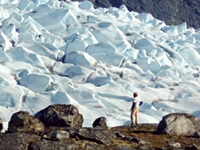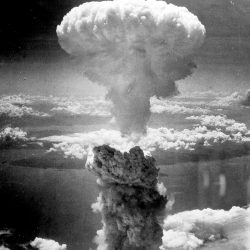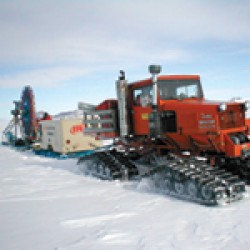Where, Oh Where, Will the Water Go?
Greenland study may offer clues about impact of melting ice sheets.

UW geologist Anders Carlson surveys an outlet glacier in southwest Greenland. Carlson and his colleagues are working to improve models for predicting changes in sea level due to climate change by studying how ice sheets in Antarctica and Greenland have melted in the past. Photo: Anders Carlson
Ice sheets in Antarctica and Greenland are melting, but no one can say for certain how much, how fast, or where all of that water is going.
“Estimates of just how much the ice will melt and contribute to sea-level rise by the end of this century are highly varied, ranging from a few centimeters to meters,” says Anders Carlson, a UW geoscience assistant professor.
The way massive ice sheets behave is one of the most uncertain aspects for scientists predicting changes in sea level due to climate change. Carlson’s goal is to remove some of the question marks with his work in Greenland, where he’s looking to the past to learn how the ice sheet melted before and to find clues about how it might melt again.
The last time Northern Hemisphere summers were warmer than current ones, the oceans were as much as twenty feet higher than they are now, a factor scientists, including Carlson, initially thought was due to Greenland’s melting ice sheet. But Carlson, along with colleagues from the UW and Oregon State University, found surprising patterns of melting that suggest Greenland’s ice may be more stable — and Antarctica’s less stable — than many surmised. The prospect is “scary,” Carlson says.
“In one person’s lifetime, you could see a significant amount of that sheet disappear, and that could have major societal impact,” he says. Rising sea levels will erode coasts and cause more frequent coastal flooding; some island nations will disappear entirely.
Carlson and his colleagues analyzed silt from cores they collected from the ocean floor off the southern tip of Greenland, where water from the melting ice sheet deposits sediments, and traced it back to one of three regions.
The sedimentation patterns showed all of the regions still had some ice cover throughout the last warm period, which was around 125,000 years ago.
The research team applied those results to existing ice sheet models and found melting Greenland ice was responsible for less than half of the total increase in sea level at that time. That means, Carlson says, that the remainder must have come from a melting ice sheet in Antarctica that was likely much smaller than it is today.
And the results also do not bode well for the future of Greenland’s ice sheet. Temperatures during that time period were similar to those expected by the end of this century, and present-day temperatures have already reached a point that Greenland’s glaciers are melting.
“Greenland still retreated during this period, and it definitely raised sea level at an amount that would destroy the lives of many, many people,” Carlson says.
Carlson and his colleagues are working to establish a half-million-year record of Greenland, up to the present day, to see how the ice has responded to warmer-than-current summers in the past. They plan to drill new cores from more locations and try to gather even better information on the evolution of Greenland’s ice sheet to aid future projections.
“All models are wrong. Some models are more wrong than others. They always have some missing pieces,” he says. “This is a way to see which ones do a better job.”
Published in the Winter 2011 issue



Comments
No comments posted yet.